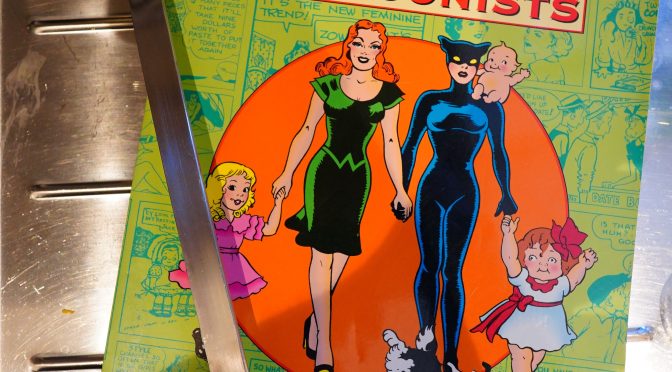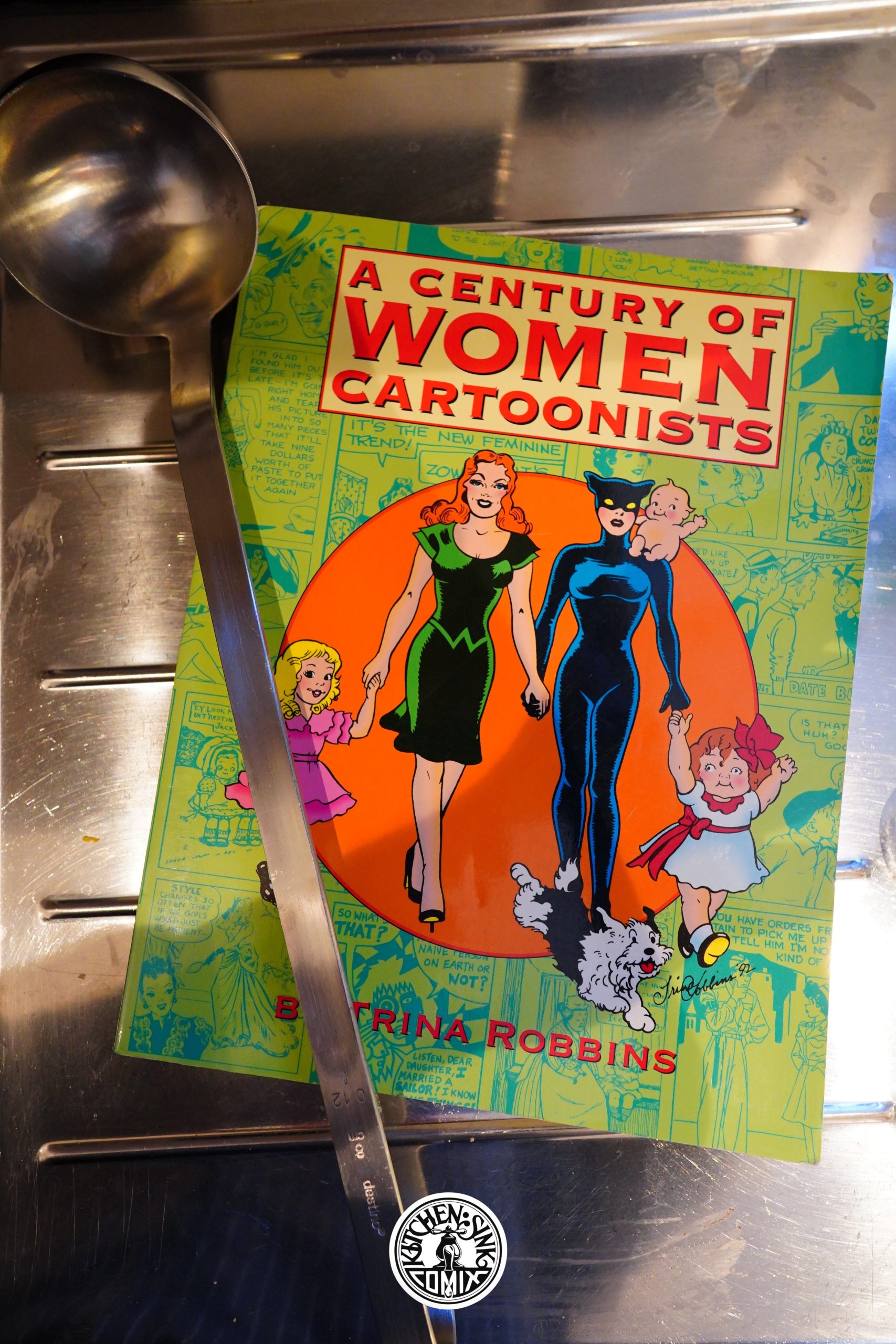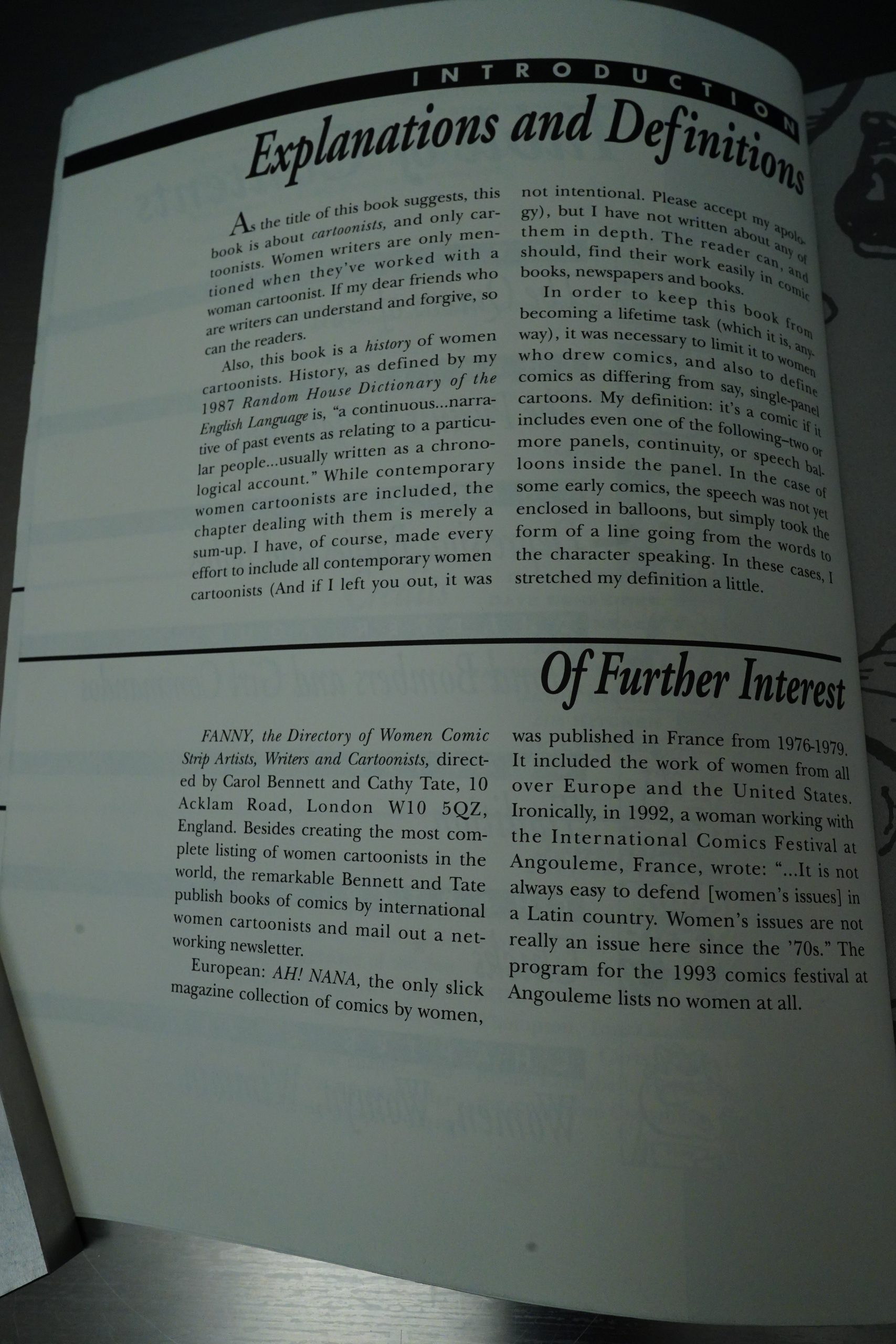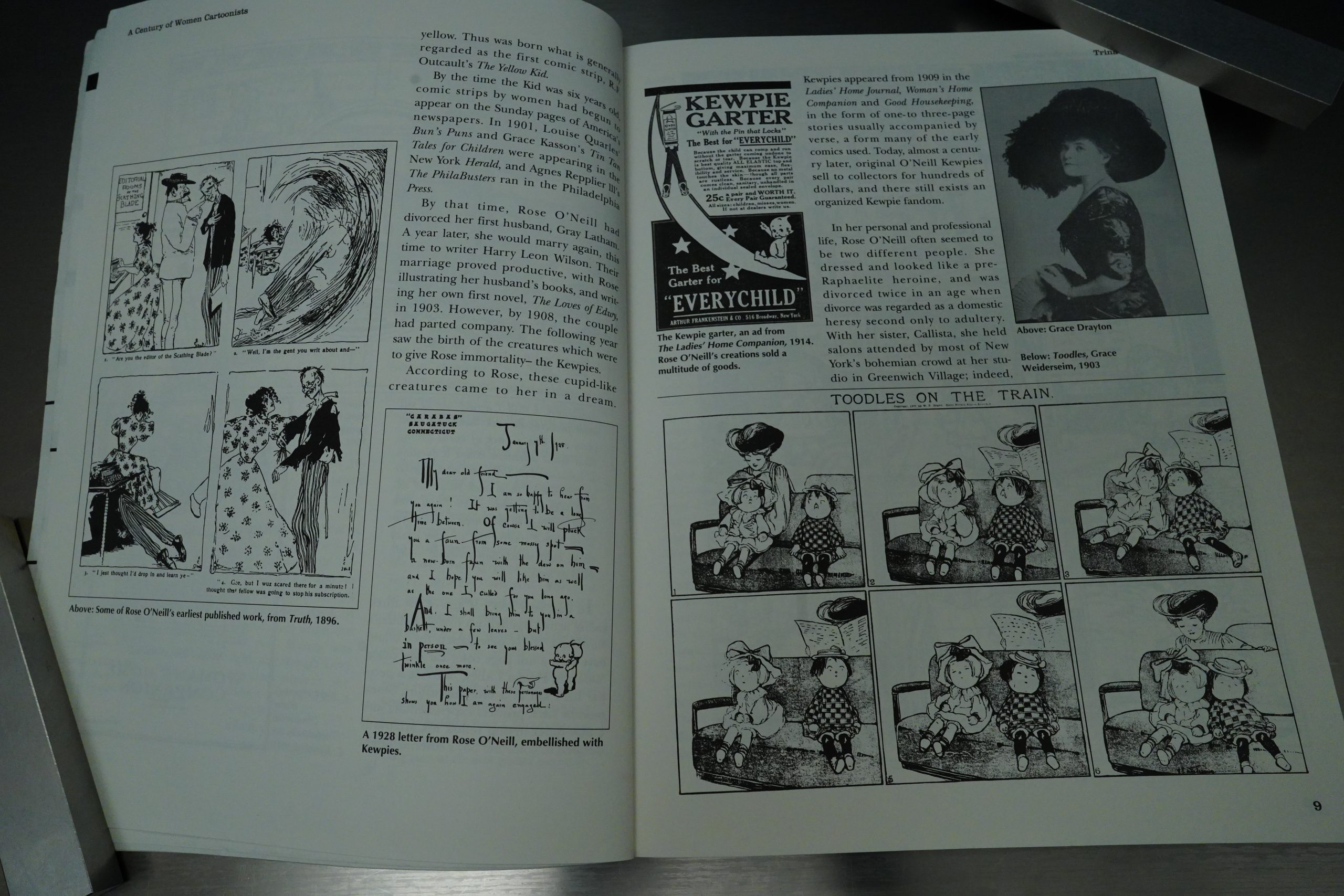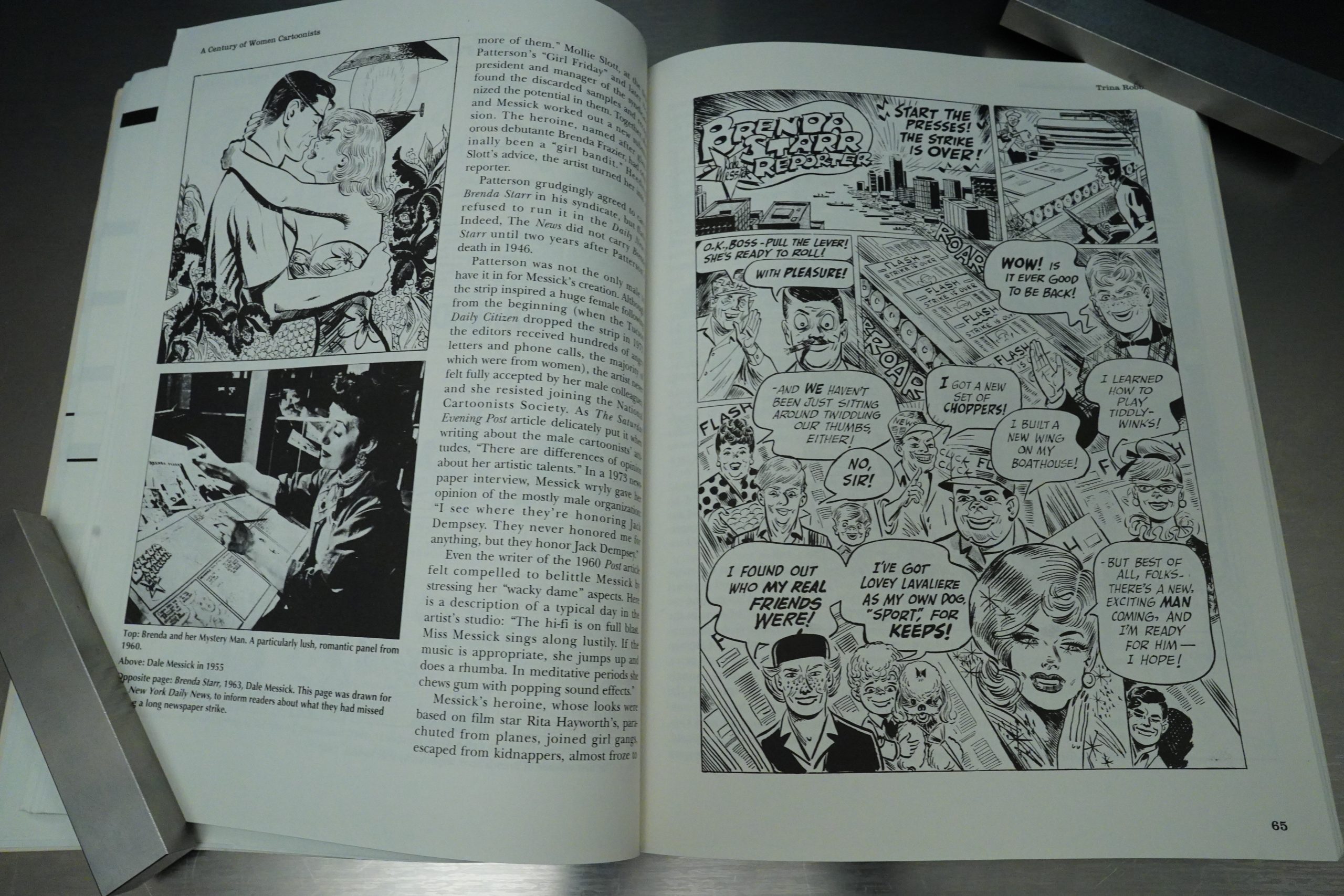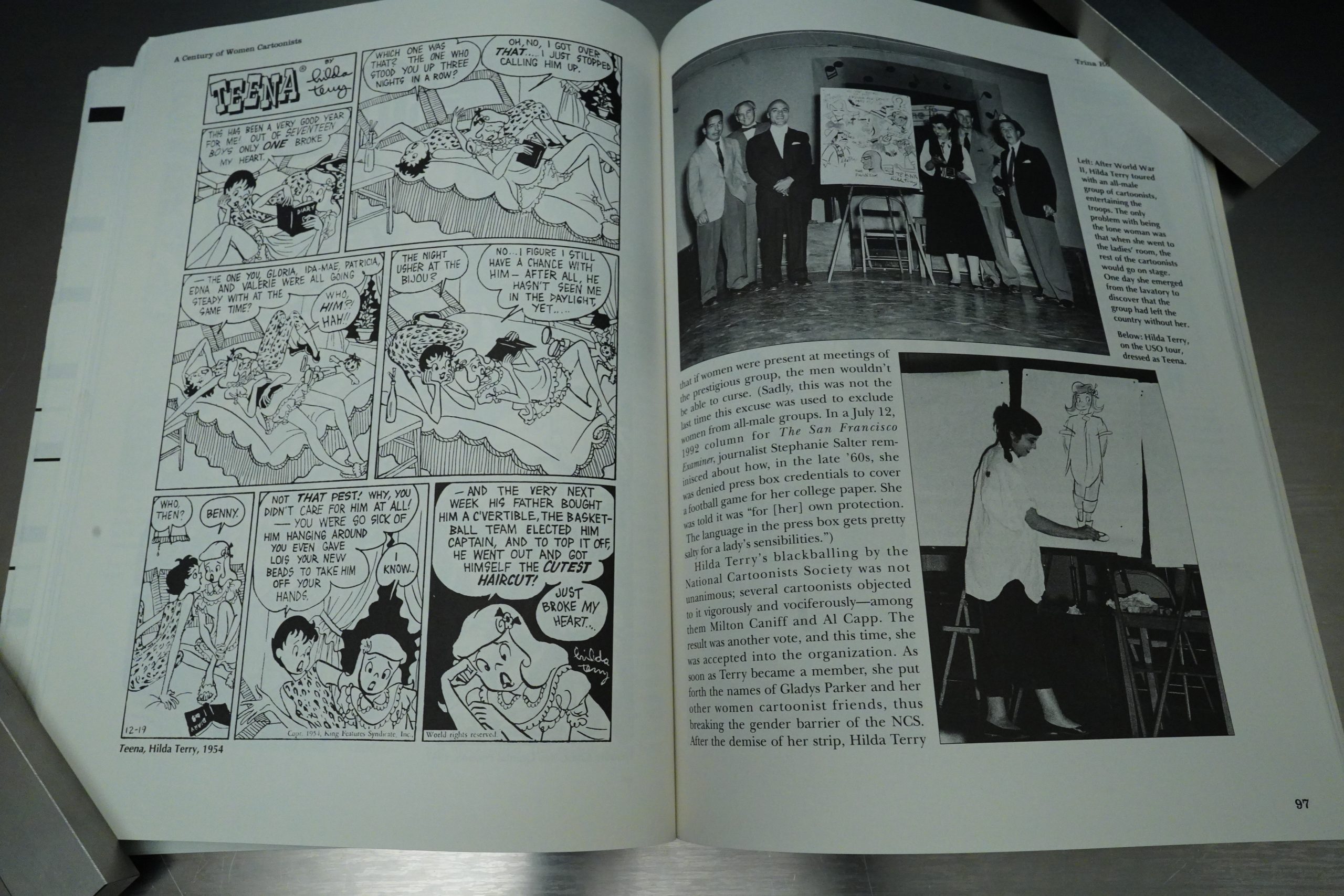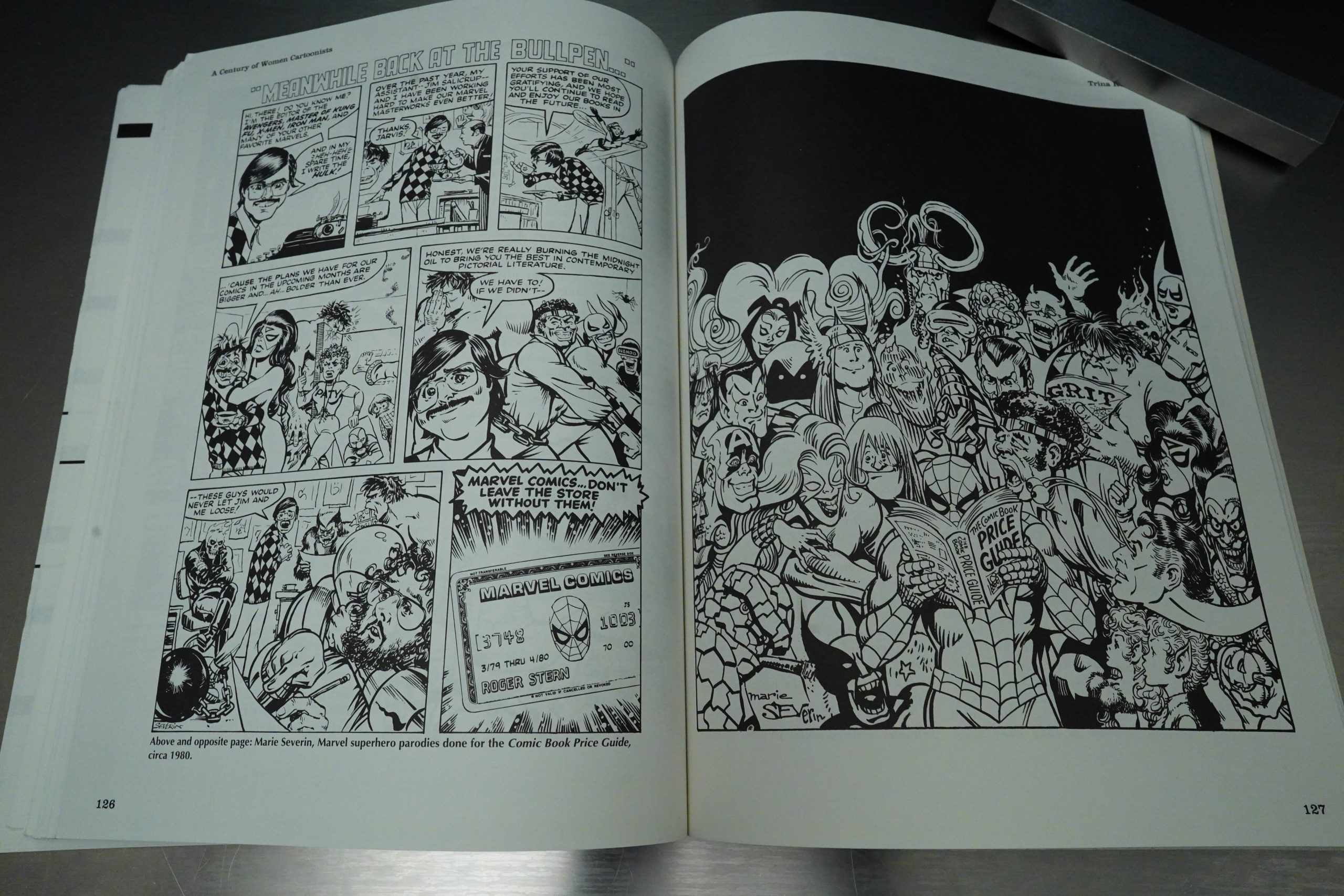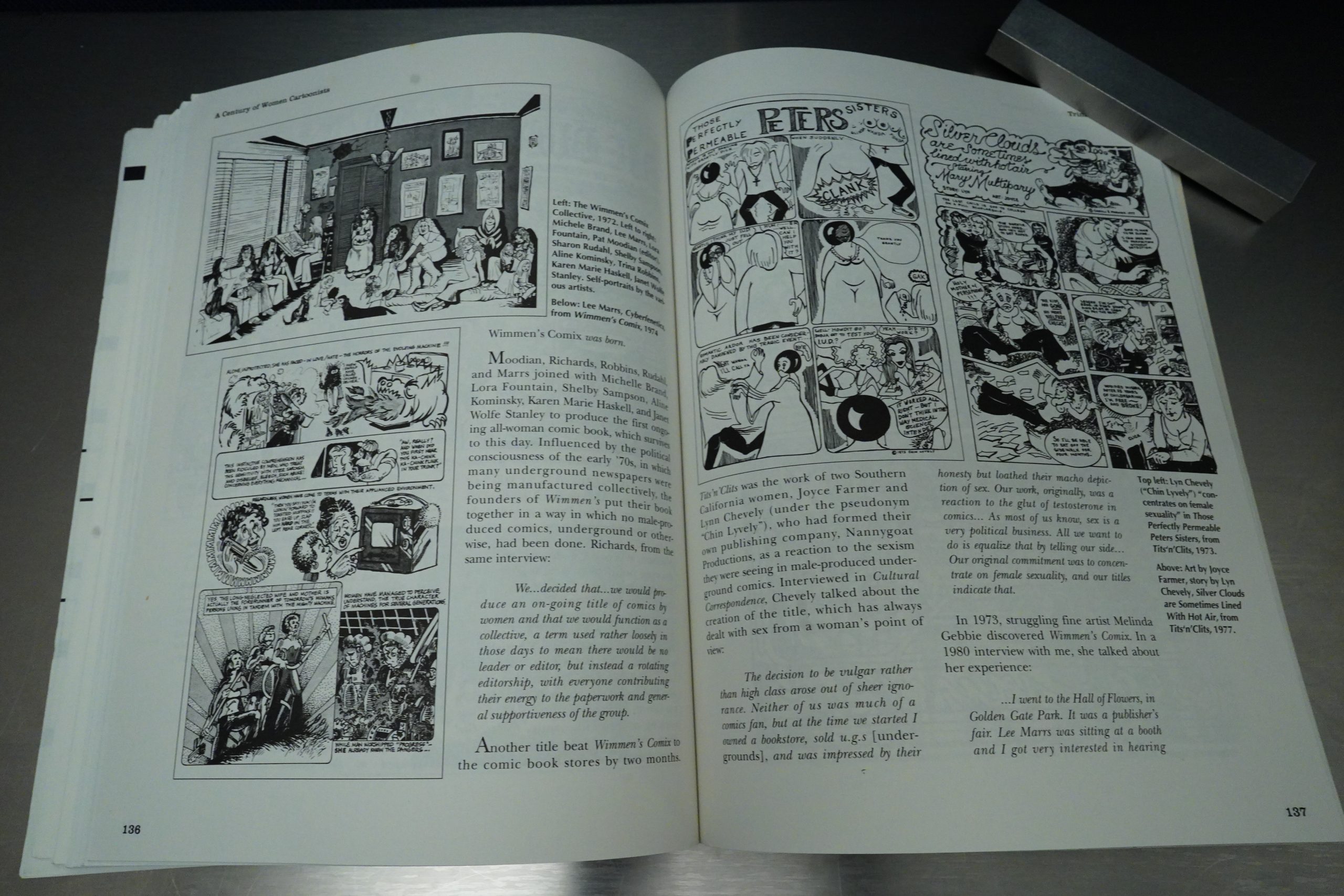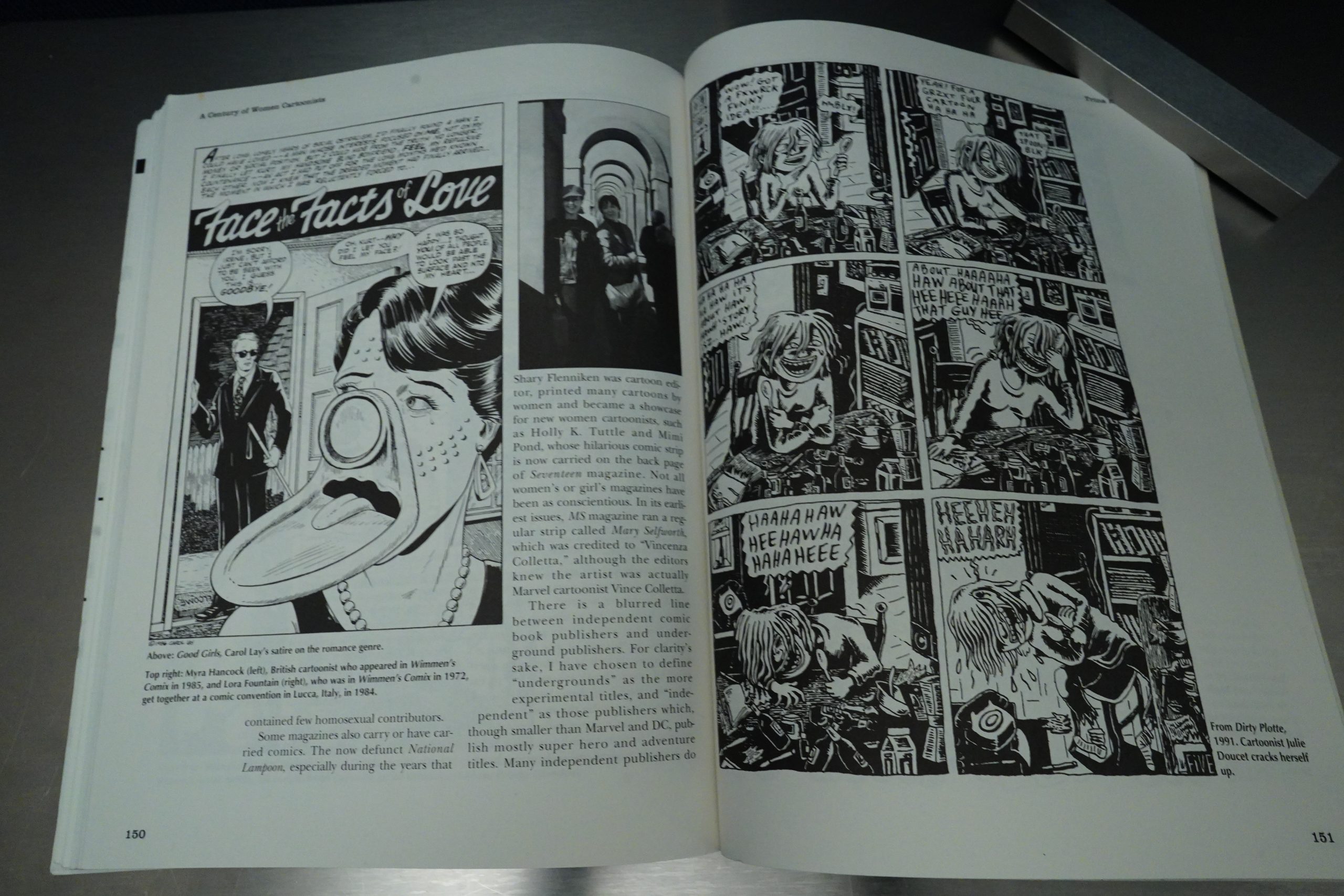A Century of Women Cartoonists (1993) by Trina Robbins
Robbins had previously done the Women and the Comics book with catherine yronwode. That book attempted to exhaustively uncover all women who’d worked on comics, because nobody had done that before, and the common myth (at the time) was that there had only been a handful of women (at most) involved with comics. Even obvious important pioneers like Nell Brinkley had been written out of history.
It’s a good book, but suffered slightly under the weight of trying to jam so many people in.
(Oops, wrong white balance on my snaps here… sorry…)
Robbins opens with an introduction where she explains what this book is about. She also laconically notes that there were no women at the programme for Angoulême in 1992 at all (and that basically would continue to be the case for the next couple of decades).
This book goes more in-depth into the careers and lives of a few dozen central cartoonists.
About two thirds of the book deal with pre-60s artists, which makes sense — those are the people we knew least about, so it’s more interesting to uncover their stories.
We get a whole bunch of illustrations to go with the text, but unfortunately, a lot of it isn’t reproduced as well as you could wish for. These are probably mostly shot from newspaper pages or microfilm, so that’s understandable.
When we get to more recent times (FSVO), the reproduction becomes a lot more appealing.
The stories Robbins choose to tell are mostly pretty familiar ones — to me, but that’s because I’ve read the previous Robbins book, I guess.
Heh heh.
While the book seems to be more into talking about cartoonists from 1920, it does stretch all the way into the present day, and we get an overview of pretty much all women involved in underground comics…
… as well as a chapter that lists many women doing comics at the time in 1992.
And, of course, sexism and sexual harassment.
It’s a solid book, that’s written in an non-stuffy, chatty kind of voice — it’s just a good, entertaining read, really. And interesting, of course.
Carole Sobocinski writes in The Comics Journal #155, page 52:
From Grace Drayton, who created the
Campbell Kids at the turn of the century, to such
contemporary artists as Mary Fleener, Roberta
Gregory and Julie Doucet, Robbins provides us
with a comprehensive and fascinating study of
the hundreds of women who chose to make car-
tooning their lives. Also included in this book
is new and never-before-printed material by
women such as Jackie Ormes, probably the first
black female cartoonist, and Dale Messick’s
“Streamline Babies,” the hitherto unprinted
precursor to “Brenda Starr.”[…]
A Century of Mjmen Cartoonists is sure to
be a valuable source of reference for everyone
and possibly a means of inspiration for the grow-
ing numbers of women who choose to enter the
industry. •
Robbins writes in The Comics Journal #167, page 4:
FIRST OFF, R.C. HARVEY, permit me to
apologize for redrawi ng the cover characters on
my book, A Century of Women Cartoonists, but
since all the original artists except Dale Messick
are dead, getting them to do their own art is a
task that I must confess is beyond me.
I decided to concentrate only on women
who drew comics, as opposed to, say, single
panels, editorial cartoons, or animation, to keep
my book from getting too amorphous. I hope
that someone else (or perhaps even three some-
One elses) will put together a book on the other
subjects. I included Etta Hulme and Edwina
Dumm because they drew comics, as well as
editorial cartoons. I included comics by Marge
Henderson Buell, rather than her Saturday
Evening Post Little Lulu single panel cartoons.
It is indeed true that Rose O’Neill sold single
panel drawings to magazines in 1895, but the
earliest comic in my book (and it is undeniably
a comic) is by O’Neill, from 1896. If you will
look on page 56, you will find a comic by Alice
Harvey. A comic by Roz Chast is on page 158.
Absolutely none Of the text in A Century Of
Women Cartoonists is lifted verbatim from
Women and the Comics, although I did, of
course, write half Of that book. You think I
wanna get sued?
While my book certainly is “a celebration
of women cartoonists whose achievements
pleased Robbins,” I also included women whose
work I absolutely can’ t stand. The criterion was
whether they drew comics, not •whether I like
them.
I apologize for the typos where Tippie is
spelled “Tippy.” You’ veprobably noticed that,
God help me, his name is also spelled correctly
in places. All I can say is typos happen, I
appreciate them being pointed out, and every
discovered typo will be corrected in the second
printing (we’ll also add that missing index!).
My knowledge of the Hilda Terry/NCS
incident was gotten from Terry herself. I know
that it is easy for people to remember things
differently after many years. I would have been
incredibly grateful if you had sent me a copy of
that wonderful letter from her to the NCS after
Women and the Comics came out, almost ten
years ago, since that information was missingin
that book, too. I have always relied Strongly on
any information given me by anyone at all —
there is only so much you can find in old
newspapers, especially if you don’t have a lead
on where to 100k. As you wrote, Carol Hudzietz
WOO’s information on her grandmother was
invaluable, as was Sally C.B. Lee’ s information
on her mother, Dot Cochran. In the front of my
book, under “Acknowledgments,” is a list of
people without whom I could not have written
the book.
I would also have appreciated, and still
would appreciate (it’ s never too late for correc-
tions to appear in the next printing!), a copy of
that letter to a friend from Dale Conner. Lastly,
I must confess total ignorance of Heidi Stetson,
Sherrie Shepherd and Lise Connell. Neither
were they mentioned to me by any of the people
with whom I did research. Are they very new?
Is there anything else you might happen to
know that you’re not telling? I welcome infor-
mation, and am eager to add your name to that
list of wonderful people in the front of my bookR.C. HARVEY RESPONDS: Um, well, yes — it
would appear, indeed, that my remarks about
the cover you drew were gratuitous and mean-
spirited. But let me clarify a bit: your drawing
was just fine. Nothing, really, wrong with it.
Were I you , I would be tempted to do exactly as
you did. (In fact, for a book of mine that’s
coming out in the summer, I have done exactly
what you did: I aped the originals.) I wasn’t
criticizing either your drawing or your selec-
tion of subjects. And while I admit to being
gratuitous and mean-spirited on occasion, in
this instance I was attempting to use the cover
to make a point. Maddeningly, the two para-
graphs Of the review that make the point turned
up missing when the review was published.
Edited out, doubtless, in order to squeeze the
article into the pages available for it. Perhaps I
can get them published here.
First, let me rehearse the setup. I began by
calling the
Miss Fury, Miss Muffett, Tippie, one of the
Campbell s soup kids — all smi ling and march-
ing out towards the reader. Something Of a
feminist crusade, I said, and something of a
celebration.
Next, I pointed out that something wasn’t
“quite right. Something’s missing.” The char-
acters were not authentic, I said — not drawn by
their creators but counterfeited by you. (Well,
counterfeited for the most part, but counter-
feited nonetheless.) Then come the two para-
graphs that missed muster when the article was
published; here they are:
“But the cover is still perfect for this book.
Its image accurately telegraphs a message about
the content of the volume. There’s something
missing in it, too. A Century of Women Car-
toonists leaves out a lot of women cartoonists.
“The cover hints at even more about its
book. If this is a book about women cartoonists,
why is the cover about women cartoon chårac-
ters? Because a little confusion reigns, that’s
why, And that, too, is an accurate reflection of
the content of the book.”
Then the review continues more or less as
you saw it in the Joumal #164. At the risk of
belaboring what ought, by now, to be obvious,
I saw the cover as emblematic of the content of
the book. The marching figures suggest the
crusading spirit of the feminist objective (res-
cuing women cartoonists from obscurity) —
somewhat militant, but, in this case, mostly
festive. Their lack of authenticity —the “some-
thing missing” — suggests the women cartoon-
ists who are not mentioned in your book. And
the use of women characters rather than women
cartoonists conveys a sense of confusion, pre-
cisely what I think your selection of cartoonists
and your definition of “comics” betray. You
imply that you had to be selective rather than
all-inclusi ve and that consequently you included
only comic book and comic strip cartoonists.
But—as I point out in my review —you didn’t
include all the “comics” cartoonists that you
could have included, and by concentrati ng upon
just that genre, you neglect some ofthe greatest
female names in the history of the medium, To
draw my attention to a comic strip by Alice
Harvey on page 56 of your book ignores the
criticism that your book passes over the most
significant part of her cartooning career, the
magazine cartoon part. And by passing it over,
you effectively dismiss it. That’s poor history.
You say that “none of the text in Century is
lifted verbatim from Women and the Comics,”[…]
First, just to put this all in context, what I
said was: “Much of the history text is lifted,
sometimes verbatim, from the Robbins-
Yronwode volume.” “Sometimes verbatim”;
butnot always. And I didn’t say that takingyour
history from the earlier book was a bad thing. In
fact, I said (in the sentence following the one I
just quoted): “And for that reason, Century will
serve as an interim record about women car-
toonists until Women and the Comics can be
reissued in a revised and updated edition.”
Okay, then, where’s my evidence? Let me
call a few witnesses.
From Century (page nine): ” [Rose O’ Neilll
dressed and looked like a pre-Raphaelite hero-
From Women (page 12): “[Rose O’Neill]
looked and dressed like a pre-Raphaelite
painter’s fantasy…”
From Century (page 17): ‘*Kate Carew’s
The Angel Child also debuted in 1902. (This
strip is not to be confused with Momma ‘s Angel
Child, 1908-1920, by Penny Ross, which, de-
spite the name, was by a man.)”
From Women (page seven): “Kate Carew’s
The Angel Child was also born in 1902… (Al-
though the titles and subject matter are similar,
The Angel Child should not be confused with
Mamma’s Angel Child… The latter’s creator,
Marion T. “Penny” Ross, was, despite the name,
a man.”
From Century (page 42): “Fay King, a top
cartoonist for over two decades, was referred to
by Chuck Thorndike in his 1939 book, The
Business of Cartooning, as one of the top five
women cartoonists in America.”
From Women (page 18): Chuck Thorndike,
in his 1939 book, The Business Of Cartooning,
refers to Fay King as one of the five top women
cartoonists in America. At that point her career
had spanned two decades and included work as
both a columnist and an artist. ”
Is that an echo I hear, or what? Not a perfect
echo, perhaps, but enough, I think, to make my
point without quoting more examples.
What a tool. He claimed that she lifted text verbatim from her previous book, and… includes examples that show no verbatim lifts, but still insists that he’s right. And Robbins never claimed that this was supposed to be an exhaustive listing of all women working in comics.
R C Harvey writes in The Comics Journal #164, page 41:
That book is now out of print, we are told.
But this new book will not take its place.
Robbins’ solo effort is both more and less than
the Robbins-Yronwode tome. Robbins sup-
plies more information about a few cartoonists
— Virginia Huget, Dale Messick, Dot Cochran,
Caroline Sexton — but she deliberately leaves
out all cartoonists who did not work in
the sequential cartoon strip formats of
the newspaper or the magazine (i.e,
comic books).
In other words, she leaves out such
notable figures as The New Yorker’s
Helen Hokinson, Esquire’s Dorothy
McKay and Barbara Shermund and
Mary Petty, and Other single-panel
cartoonists like Ethel Plummer and Alice Harvey
(whose work appeared chiefly in the old humor
magazine Life), Barksdale Rogers (in Judge),
and Janie Berenstain, who, with her husband
YES THAT”S WHAT ROBBINS SAYS IN THE INTRODUCTION.
What a tool.
This is the one hundred and sixty-third post in the Entire Kitchen Sink blog series.
